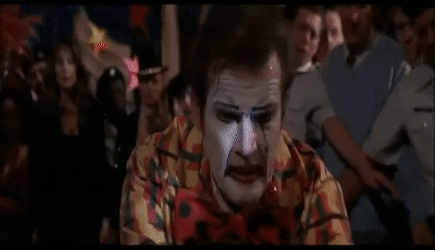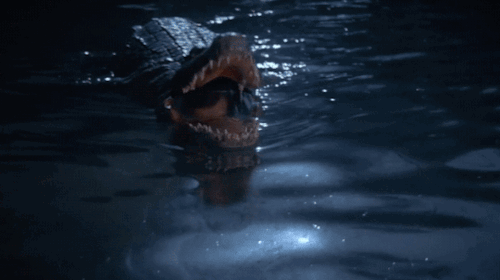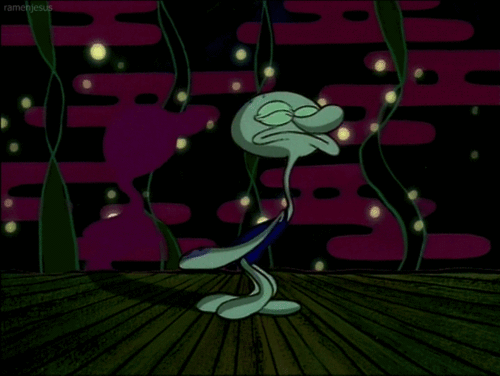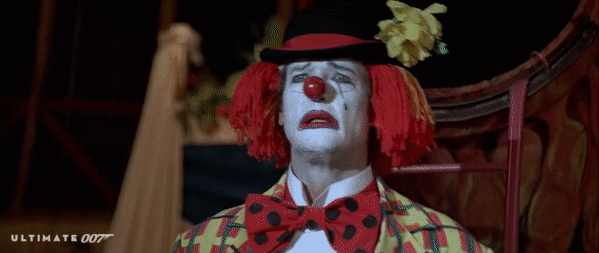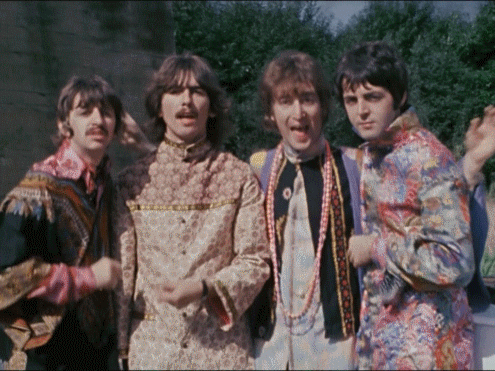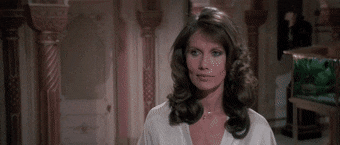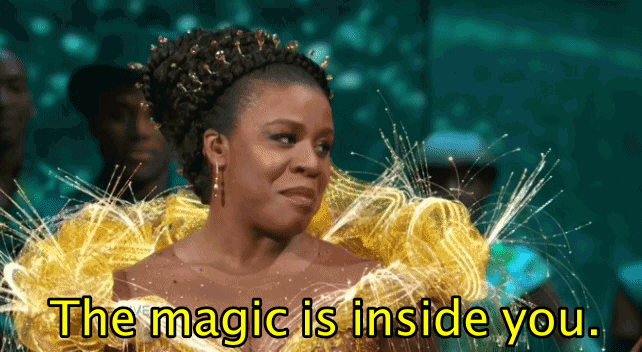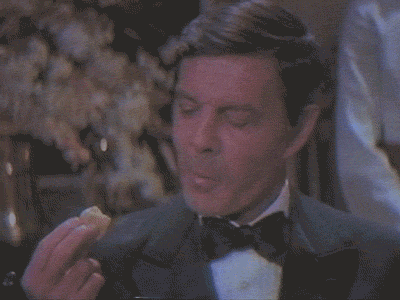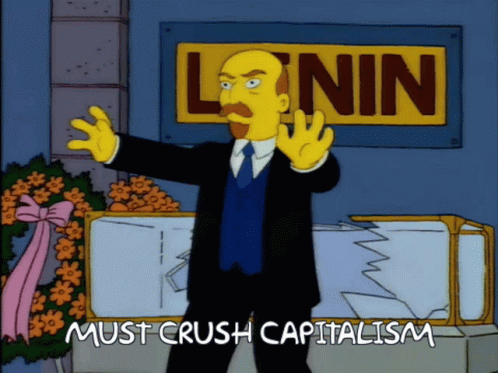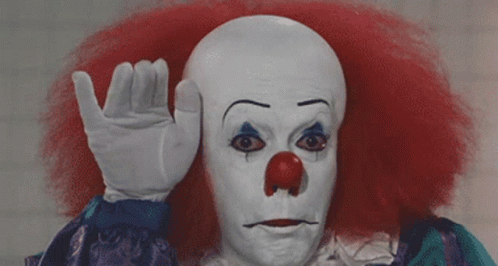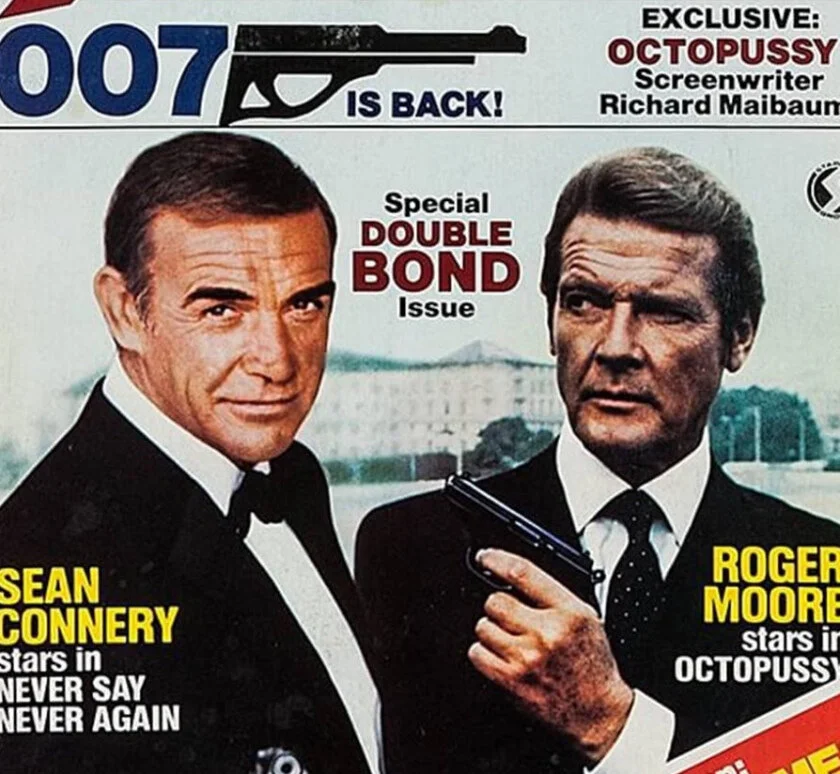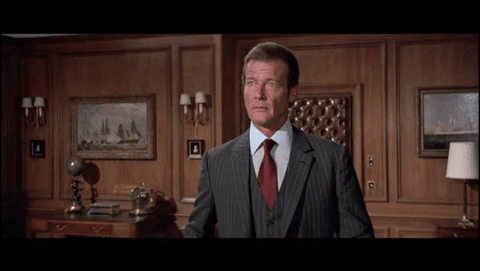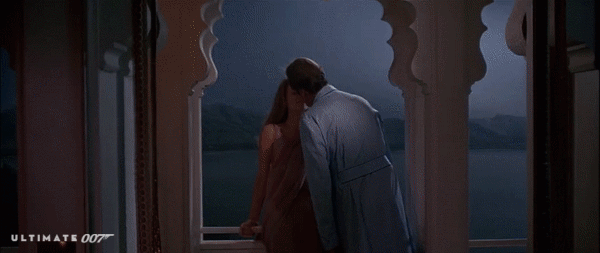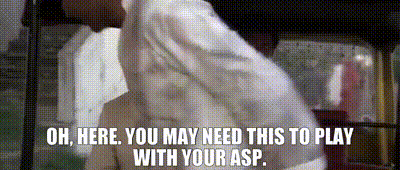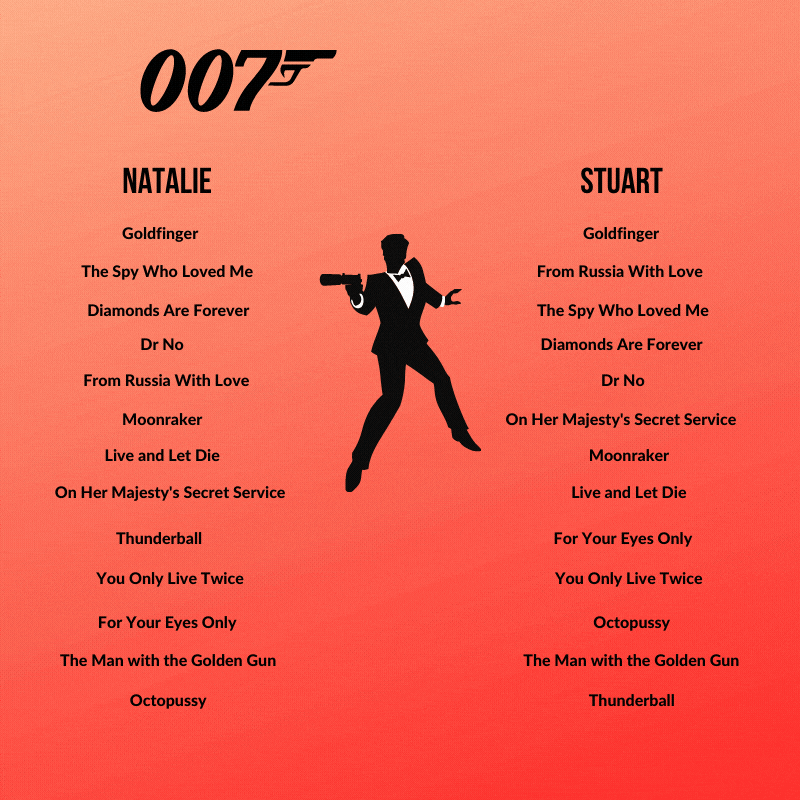Listen to the companion Raven Bond podcast here!
Released: June 1983
Producer: Albert R. Broccoli
Director: John Glen
Written by: George MacDonald Fraser, Richard Maibaum & Michael G. Wilson
Plot:
When a Faberge egg turns up at auction in London, Bond is tasked with investigating the buyer. Following exiled Aghan prince Kamahl Khan to India, Bond encounters the reclusive guru, business woman and jewellery smuggler Octopussy, and discovers a past connection. Which obviously turns into a present connection. Meanwhile, the USSR’s General Orlov goes rogue with a plan to detonate a nuclear weapon in Eastern Europe allowing the Soviet armies to roll in.
Famous For:
Roger Moore in clown make-up
Three, count ‘em, three villains
The worst theme song of the franchise
THAT FAKE CROCODILE SUB
Now look here, internet.
I spend a lot of time trying to curate the finest GIFs to accompany these essays, but I’ve discovered Google can be a dangerous pond in which to wade. Not because it is inherently devilish, but because it produces results based on the most requested content, which in turn is prompted by the base desires of the humans using it.
So explain yourself, humanity - why is it that a simple search for “Octopussy” turns up the naughtiest nautical pornography? Why is the humble octopus, or its cousin cephalopod the squid, the focus of such debauched copulatory incidents? What did the poor creature do, to warrant it being yanked from a calm life on the sea floor, placed in a crusty studio and made the unwilling star of its own heinous hentai?
Talk about releasing the Kraken.
And you call yourselves environmentalists. Sort yourselves out, internet.
It’s a fate Eon producers probably should have thought more about when they decided, screw it, let’s just make a film called Octopussy and hang the consequences.
Sure, it was a Fleming title, and sure, it’s totally in-keeping with the tongue-in-cheek nature of the franchise, but surely they had perverts in 1983?
The long term embarrassment might have been mollified if the content of the film was top class, but unfortunately, Octopussy remains one of the most confusing instalments of the series, with a wildly scattered script.
The thing is, I still enjoyed some of the more batshit crazy elements of this film. In that sense, it falls in alongside something like The Man With the Golden Gun. However, where that film had a nonsense plot but a very strong, clearly defined villain (and henchman), Octopussy has three competing villains and what appear to be two competing movies within it - an Eastern European espionage thriller and a romantic adventure in India.
Also, let’s face it, it has the most forgettable Bond theme song of the series, despite being composed by John Barry and with lyrics by Tim Rice. Yes, THE Tim Rice. A turgid adult contemporary ballad, it features the worst kind of 80s synth and porno saxophone. “All Time High”? Somebody was high.
So let’s take a look at what Octopussy gets wrong, but also praise the fun moments - intentional or otherwise. Yes, including that clown makeup.
The primary source of the trouble stems from the writing. Scottish author George MacDonald Fraser was hired to create an early draft of the script, and it was he who proposed the India setting, as the franchise had yet to feature the subcontinent. The incongruities probably arise from the rewrite longtime Bond writer Richard Maibaum and producer/Broccoli stepson Michael G. Wilson did on Fraser’s draft.
The plot was a mish-mash of two Fleming short stories published after his death: the auction of the Faberge egg was taken from The Property of A Lady; while Octopussy itself was a short story told from the perspective of a war hero Major Dexter Smythe, who stole a cache of Nazi gold and murdered the only other person who knew of its existence. Bond allows Smythe to take a swim in the sea, where he lets himself be stung by his “pet” Octopussy, as an alternative to a court martial.
This story was used as background for Octopussy herself, who in the film is Smythe’s daughter, and grateful to Bond for letting her father have an honourable death. She has leveraged a talent for jewellery smuggling into a legitimate business empire, running circuses and tourist enterprises alongside a spiritual wellness and martial arts training retreat for women, which she admits to Bond is all about providing the destination disillusioned people seemed to be looking for.
Now I’m always happy to see a 1983 film making digs at the culture of Westerners travelling to India to seek spiritual enlightenment from mystic gurus.
Pictured: some random hacks.
Not that it stopped the New Age truthseekers of course. If anything, Octopussy’s fightin’ feminist ashram seems like the ideal place to sit out a global pandemic, which ironically is the only thing that might have actually put a dent in visitation numbers.
So the idea of Octopussy is that she has status and power, and casting Maud Adams - a rare returning Bond babe after playing Andrea in The Man With the Golden Gun - was seen as an age appropriate choice to match Roger Moore. He was 56. She was 38. Ahh, Hollywood.
Sadly, she’s not given a huge amount to do, because her role is as the “ambivalent” baddie who is persuaded to switch sides, which let’s face it in this franchise is inadvertently always a bad gal who falls under the spell of Bond’s magical penis.
Octopussy does her smuggling stuff primarily with Louis Jourdan’s character Kamahl Khan, an exiled Afghani prince who … wants to get his old job back? I think? His goal is never actually made clear, apart from his desire to cheat at backgammon and unsettlingly eat sheep’s eyes.
Khan is working with Soviet General Orlov (a delightfully megalomaniacal Steven Berkoff) to smuggle priceless artefacts out of the Kremlin, replace them with forgeries, and sell the real stuff in the West.
A rogue troublemaker, Orlov’s goal is to set a nuclear weapon off in West Germany, prompting disarmament by the Western powers, and leaving the borders open for the Soviet troops to march through Europe. Therefore he needs the funds from smuggled artefacts to…build a bigger army? Buy the nuclear weapon? I mean I guess he needs some assistance outside the politburo, but it’s never explained why Khan is the middleman.
Khan also seems to report to Octopussy in the earlier part of the film, where she is established as something of a mysterious figure, the kind who gets nubile young women to tattoo octopus tattoos on their butts. But later on, Khan double crosses her by conveniently having somewhere else to be rather than at the circus where the nuclear bomb has started ticking down.
The film also seems to establish Orlov as the Biggest Baddie, because of that whole “Invade the West, Come On Guys, It’s Communism’s Time To Shine!” plan.
And yet Orlov is killed off 40 minutes before the film’s conclusion in a sort of damp squib border shooting, which is something of a shame given how charismatic Steven Berkoff is in the role.
The necessity of having two competing stories necessitates two competing endings, the first of which involves that legendary decision to put Bond in sad clown makeup.
It’s a callback to the very start of the film, when Agent 009 is seen running from one of the Octopussy circuses in Berlin, being pursued by twin knife throwers Mischka and Grischka. They think he dies after toppling into a river; however, the agent manages to make it out to the British embassy, crashing through the doors and letting the fake Faberge egg roll from his grip onto the floor.
Bond knows Agent 009 died with his overly large clown shoes on, but it’s still somewhat amazing that he is able to recreate the entire costume - including the full wig and face paint - in a few minutes while hiding in a trailer at the circus with both US soldiers and German police running after him.
Now obviously the makeup helps disguise Bond, so that’s a reasonable defence of putting the world’s most suave spy into a generic Pennywise costume.
But it was Raven Bond podcast guest Tom Salinsky who pointed out a better reason to put Bond in clownface was to raise the stakes of having an atomic weapon about to explode.
From 2.42 in this clip, you see him confront the American base commander, who of course finds it hard to believe a clown when he claims there’s a bomb in the base of a cannon.
With only 90 seconds before detonation, Bond is desperate, ripping off his wig and nose and pleading with Octopussy to back him up. Unable to get an answer, Bond races to open the bomb case himself, with police and security chasing him down. The clownface allows obstacles to continue to be thrown up in front of Bond, to ensure the audience’s heart is racing and the seconds are almost gone by the time he defuses the device.
I will begrudgingly agree that it makes sense in that context. It’s something of a shame that the clown suit has had the bigger negative legacy impact on the film, especially considering how long Bond spends in one of the knife-throwing twins’ flamboyant red shirt/black vest outfits. However, the ignominy of putting Bond in clownface is something the franchise has to live with forever more.
The second ending is to conclude the Indian half of the film, and if you embrace its ridiculousness, is a lot more fun.
Octopussy and her roving band of circus cult members raid Khan’s palace with a dazzling display of Girl Power, 1983-style. It’s not the first instance of an all-girl fighting group - Pussy Galore set that precedent with her Flying Circus back in Goldfinger - but it is a lot more hands-on, and deserves credit for that.
Besides, it’s got the most insane range of combat outfits - from saris, to jumpsuits, to leather dominatrix wear. Regular readers will know how much I appreciate any kind of pussy power demonstration, and this is literally that.
And THEN Bond and Q turn up in a Union flag hot air balloon.
Of course, the question we haven’t yet posed is - why was Roger Moore still in the Bond role? He again had thought of hanging up the tux after For Your Eyes Only, but was convinced to return because 1983 was the year of The Battle of the Bonds.
Yes, our old friend Kevin McClory had finally got enough interest and money together to film Never Say Never Again, with Sean Connery returning to the Bond role. Moore was seen as Eon’s best chance to beat Never Say Never Again at the box office, because imagine the embarrassment if they didn’t.
In For Your Eyes Only, jokes had been made about Bond’s age, mostly in relation to the Bibi Dahl as the underage Bond girl with a thirst for 007-Up storyline. Indeed, Never Say Never Again is basically all about Bond being older and creakier, but with enough old school know-how to be deadly in the field.
Conversely, Octopussy makes no reference to Moore’s age, and if anything, softens the filters more to smooth out his forehead lines as much as possible.
Don’t. Express. Emotions.
It also puts Bond through the physical paces - well, Moore’s stuntman at any rate - with a spectacular train-top fight, Bond hanging from the side of said train, and the objectively good final sequence where Bond jumps from a galloping horse onto the back of Khan’s getaway plane, the fights with his henchman Gobinda in mid-air:
His physicality is also used for comedy, such in the chase sequence at Khan’s palace, in which Bond becomes the ultimate prey. Moore tells a tiger to sit, lets a snake crawl over his legs, and even gets totally Tarzan on some vines.
Yep, they just laid that Johnny Weismuller vocal track right on there.
There are other moments of fun in the film.
The pre-credit sequence, unrelated to the rest of the film, sees Bond impersonate a Cuban general, complete with fake moustache. Unable to find room for it in Moonraker, the hero bit of kit is the microplane, conveniently carted around disguised as what could now be described as a giant metaphor for the whole film.
Magda is a strange Bond girl, whose allegiance seems to flow between Khan and Octopussy, and who has an unfortunate expression that seems to make her look like she’s just smelled something awful. Perhaps the script.
She does, however, have the best exit from a Bond tryst, using her sari as an escape rope and gracefully repelling off a balcony, leaving the scene in a bikini and Khan’s car.
I had a visceral reaction to seeing animals such as elephants, bears and baby tigers used in the circus in West Berlin, showing the change in circus practices in fewer than 40 years. In a similar way, the use of street performers such as fakirs and sword swallowers during the chase sequence in India is now a bit cringey with our 2020 vision.
What is great about the India portion of the story is Bond’s local liaison Vijay, played by real life Indian tennis star Vijay Amritraj (whom Broccoli cast after seeing him at Wimbledon). It’s a great part, even if Vijay plays the actual Bond theme on a recorder to make contact with Bond, and he shows incredible grace dealing with Bond’s sub-par subcontinental puns.
It’s a credit to Amritraj that while we’re used to Bond’s location contacts winding up dead, Vijay’s untimely demise is really sad. He’s been swapping watch duties with Q while Bond is over on Octopussy’s floating palace in Udaipur, and is set upon by Khan’s goons, including a dude with a really savage-looking razor blade yo-yo device.
Bond has the grace to look upset when he returns to the shore - having travelled there and back in the aforementioned one-man crocodile submarine, another highly specific and slightly naff creation of Q’s. Thankfully Vijay lived long enough to tell Q critical information, but not critical enough for us to see it.
Q is used a lot in this film, and I am always up for more Desmond Llewellyn on my screen. As per The Spy Who Loved Me and Moonraker, Q sets up a remote M16 lab specifically to assist 007 in the field. Very well-resourced, this Secret Service (as opposed to the budget cuts and red tape referenced in Never Say Never Again).
It’s during this scene that my feminist senses clashed with my inner sniggering 12-year-old boy. In a moment that seems to be a paean to the Carry On films, or perhaps the Benny Hill Show, Bond uses a high quality video camera to… well, see if this in any way surprises you.
I mean, sure, it’s workplace harassment, and sure, I wouldn’t condone such a shot.
EXCEPT I PROBABLY WOULD BECAUSE I’M A TERRIBLE PERSON AND BOOBS ARE JUST FUNNY AND PLEASE FORGIVE ME SISTERS
Frankly, given the bouncy zoom effect, I was surprised editors didn’t add in suitable foley effects for the boobs. I have taken it upon myself to gather a range of options that could have been used.
May I present my Sonic Smorgasbord of Norgs:
Yes, that’s right, instead of spending creative time on brainstorming new plays, or other pop culture analysis pieces, or even tidying my house, I devoted a number of hours to finding sound effects for boobs.
AGAIN I REPEAT I AM A TERRIBLE PERSON.
And so while Octopussy is a bit of a confusing mess, I can’t be that hard on it because I, too, am trash.
Ultimately, Octopussy won The Battle of the Bonds, taking in about $25 million more in box office receipts. Eon Productions had won, it had defeated Kevin McClory. Which meant…they couldn’t get rid of Roger Moore. Not now, after he’d beaten OG Bond Sean Connery head-to-head. Recasting now would mean admitting they only kept Moore because they were scared. He had to keep going, or they’d all look silly.
But hey, Eon’s riding an All Time High. What could go wrong?
Time to start production on A View to a Kill.
Thank you for reading this instalment of the James Bond Retrospective! If you enjoyed it, you can sign up to support the series and my other writing/podcasting efforts via my Patreon page. Thanks to all of you who are already members; your support is truly invaluable.
You can listen to the companion Raven Bond Octopussy podcast here:
We also put up another little mini-pod in which Tom talks about being in the room where it happened, with “it” referring to the first performance of what would become Phoebe Waller-Bridge’s seminal hit Fleabag.
And if you’re looking to hear more Tom Salinsky goodness, his Best Pick Podcast is a genius dissection of all the films that have won the Best Picture Oscar. He and his co-hosts are about two-thirds through, so there’s a wealth of cinematic gold to mine.
Stu and I have are also ranking the Bond films as we watch and podcast about them. Here’s how we stand:
See you next time for … gasp!…surprise! We’re doing Never Say Never Again!
